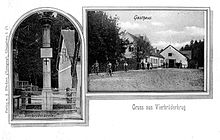Four brothers column
The four-brother column was a column near Königsberg in the Kaporner Heide . The reason for its construction and its purpose are not certain, attempts at explanations circulating in the nineteenth century established a connection between the column and the story of four brothers of the Teutonic Order who had undertaken a raid in 1295, were pursued on their way home and then became victims of one themselves Should have been attacked. A survivor is said to have erected a black memorial cross at the location of the bloody act; Landmeister Meinhard von Querfurt later had a monument erected instead of the cross.
Description of the column
The column, originally a black wooden cross, later rebuilt as a stone stele, showed four bearded, helmeted male heads in the capital. The coat of arms of the Teutonic Order and a plaque with the following slogan had probably been attached to the column itself since 1900 at the latest
Twelve hundred and ninety-five - the chronicle names this year
At the time when Meinhard von Querfurt was Master of the Order,
four brothers in arms were resting here in the grove,
From Sudau'n returning victoriously back to Bloody Strauss.
There was the brave Dyvel, the robust Kobenzell
and Stobemehl and Röder, a brave fellow.
The loyalty they had pledged to the order was
often tried out in battle in Gau'n full of revolt.
They sat happily at the meal, after Conovedit's castle.
Then the enemy's supply rushed out of the thicket.
With sword and spear and club he strikes down the four.
and in memory of the dead this column stands here.
Interpretations of the column
Johannes Voigt and Johann Georg Theodor Grasse mention different, circulating interpretations of the column. For example, Voigt mentions the interpretation of the four faces as gods of the path, Grasse the possibility that the column stands in the place of a four-branched oak tree worshiped by the Prussians. Furthermore, both mention the interpretation of the column as a memorial for four executed murderers, or as a reminder of a common hunting pleasure of four princes (Voigt and Grasse each name different princes).
Grasse considers the interpretation of the column as an honorary column for victory and booty return of four friars to be most likely. Voigt argues in favor of a different interpretation: The column serves to remember four slain brothers of the German order. Voigt suspects that Martin Golin , who had his residence nearby, may have erected the column in memory of four of his colleagues buried in the area who were also half-brothers of the order. Voigt also connects the name of the heather to this event, because in Prussian "kapurnei" means a grave.
This interpretation of the column is not covered by the historian Peter von Dusburg , to whose work "Chronicon terre Prussie" from the 14th century Voigt also refers, as Peter neither mentions Martin's residence nor the erection of a column. The poem attached to the column nevertheless refers to names and events from the chronicle.
place
Next to the column was the so-called "four brothers mug". The inn was built in the middle of the forest around 1730. With its beer garden, it was a popular place for excursions. Neither the inn nor the column have survived.
photos
Dissertation on the column of the four brothers in the Fischhäusische Heide (1717)
literature
- Johannes Voigt : History of Prussia from the oldest times to the fall of the rule of the Teutonic Order . Volume 4: The time from the subjugation of Prussia in 1283 to Dieterich von Altenburg's death in 1341 . Königsberg 1830, pp. 489-493.
- August Eduard Preuss : Prussian country and folklore or description of Prussia. A manual for primary school teachers in the province of Prussia, as well as for all friends of the fatherland . Bornträger Brothers, Königsberg 1835, pp. 504–505.
- Robert Albinus: Königsberg Lexicon. City and surroundings . Flechsig, Würzburg 2002, ISBN 3-88189-441-1 .
- Johann Georg Theodor Grasse : Book of legends of the Prussian state . Volume 2, Glogau 1868/71, pp. 545-546.
Web links
- Grasse: Sagenbuch on Zeno.org , accessed on June 9, 2015.
Individual evidence
- ↑ a b Johannes Voigt : Geschichte Preußens , Volume 4, pp. 589-593 .
- ^ Johann Georg Theodor Grasse : Book of legends of the Prussian state . Volume 2, Glogau 1868/71, pp. 545-546.
- ^ A b c August Eduard Preuss : Prussian country and folklore or description of Prussia. A manual for primary school teachers in the province of Prussia, as well as for all friends of the fatherland . Bornträger Brothers, Königsberg 1835, pp. 504–505.
- ↑ Since Voigt and Grasse both wrote before 1900 and do not mention the table, it is possible that the table, which puts a certain interpretation of the column in the foreground and makes it more binding, was not attached at that time.
- ↑ Johannes Voigt : Geschichte Preußens , Volume 4, p. 591 ff.
- Jump up ↑ Petrus de Dusburg: Chronicon terrae Prussiae . Edited by Max Toeppen , in: Scriptores rerum Prussicarum , Volume 1, Leipzig 1861, Pars III, c. 198, p. 139 and Pars III, c. 218, p. 149.
Coordinates: 54 ° 42 ′ 23 " N , 20 ° 18 ′ 53" E



